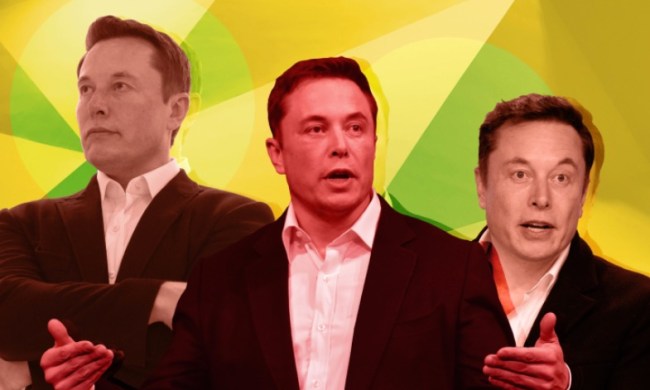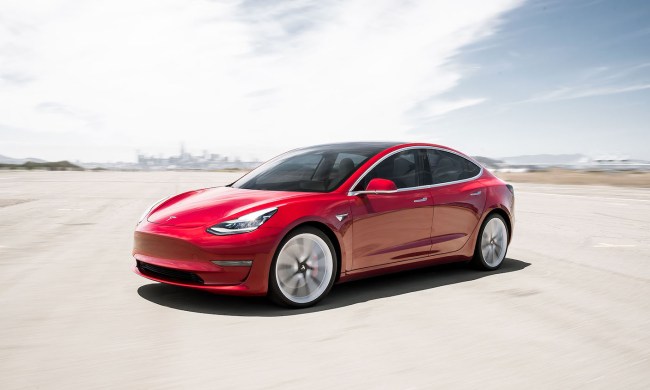It’s 2020, and everyone’s a little disappointed that the flying cars aren’t here yet. But one 1980s fantasy of the future may soon come true: One day soon, your Tesla could be talking to you.
Tesla CEO Elon Musk appeared to show off a new feature for his electric cars: The ability to talk to people outside of the car in a British accent. Musk added that the talking car could cause some “epic robber confusion” by adding the functionality to the car’s already existing sentry mode, a monitoring system that’s part of the car’s security.
Teslas will soon talk to people if you want. This is real. pic.twitter.com/8AJdERX5qa
— Elon Musk (@elonmusk) January 12, 2020
The tweet is the latest in a series of pie-in-the-sky promises from Musk, who is often quick to show off an exciting new feature, but often isn’t as cavalier about the details. The talking ability has no release date, and Tesla told Digital Trends in an email that “Elon’s tweet is the extent of what we’re sharing right now about this.”
Announcing new Tesla features with delayed follow-through, or none at all, has a bit of a pattern for Musk. Digital Trends reported in February of last year that Tesla would be rolling out a fleet of autonomous Teslas (that would still need drivers behind the wheel) before the end of 2019. It’s the beginning of 2020 and those have not materialized.
The list of these types of promises is extensive, so much so that there’s an entire website to track them: ElonsBrokenPromises.com has tracked some of these. Here’s some of the (many) Tesla promises Musk has made, without actually delivering.
Model 3 production
In 2017, Musk stated that the company would make 500,000 Model 3s in 2018. He then kept shifting the goals, saying they would make 20,000 a month, and then 5,000 per week. Actual production of Model 3s in 2018 were 8,180 in Q1, 28,578 in Q2, 55,840 in Q3, and 61,394 in Q4.
Tesla made 0 cars in 2011, but will make around 500k in 2019
— Elon Musk (@elonmusk) February 20, 2019
In total the company produced 152,992 Model 3s in 2018. That’s an average of fewer than 3,000 per week — all in all, significantly less than the company promised.
Self-driving Autopilot
Musk has set himself a lot of deadlines for when his cars will be fully automated. For instance, in 2016 he tweeted a Wall Street Journal article about how his cars would be able to make self-driving cross-country road trips “within [the] next year.”
Tesla expects to demonstrate self-driven cross-country trip next year https://t.co/YTxMUT3hWq via @WSJ
— Elon Musk (@elonmusk) October 20, 2016
In 2017, he was asked on Twitter when the cars would have “full self-driving capabilities,” and answered, “3 months maybe, 6 months definitely.” It’s 2020 and neither of those has happened yet: A statement on Tesla’s website says “all new Tesla cars come standard with advanced hardware capable of providing Autopilot features today, and full self-driving capabilities in the future — through software updates designed to improve functionality over time.”
You even have to pay more for it: Autopilot is an additional $7,000 on top of the car’s sticker price, and Tesla says it will have additional capabilities “later this year,” including “automatic driving on city streets.”
In other words: Pay us the money now and at some point in the future your car will drive itself, we promise.
Robotaxis
In April 2019, Musk declared that Tesla will have a million autonomous robotaxis on the road in 2020, and said it would eventually make cars without steering wheels or pedals. Tesla would have to significantly ramp up production to hit that mark — not to mention get regulatory approval from many government agencies — and even Musk himself warned that it may not happen this year.
This is why it’s possible for Tesla to have a million robotaxis by end of 2020 if we upgrade existing HW2 fleet of ~500k & make at least ~500k FSD cars
— Elon Musk (@elonmusk) July 8, 2019
“Sometimes I am not on time, but I get it done,” Musk warned investors during the Tesla Autonomy Investor Day.
The infamous Cybertruck windows
During the unveiling of the Tesla Cybertruck in November, Musk promised that the windows on the Cybertruck are bulletproof and then had someone hurl a metal ball at the glass — which promptly broke. To be fair, Musk later posted a video of a pre-launch demo that went over much more smoothly.
Franz throws steel ball at Cybertruck window right before launch. Guess we have some improvements to make before production haha. pic.twitter.com/eB0o4tlPoz
— Elon Musk (@elonmusk) November 23, 2019
The 420 tweet
Let’s not forget Musk’s August 2018 tweet, where he said he was considering taking Tesla private.
Am considering taking Tesla private at $420. Funding secured.
— Elon Musk (@elonmusk) August 7, 2018
That ended up being a big nothing-burger. Musk had not secured funding, as it turned out, and ended up doing nothing of the sort. MarketWatch at the time called Musk “reckless in his statements” and that he had “developed a reputation of overpromising and underdelivering Tesla’s results.”
This one had big consequences for Musk — in October 2018, Musk agreed to pay a $20 million fine to the Securities and Exchange Commission (SEC), and also had to step down as the company’s chairman for at least three years.
The Gigafactory
There’s the legendary Gigafactory 2 in Buffalo, New York. Musk took $750 million in subsidies while singing the familiar song of “jobs for all” to build a new solar cell-producing factory, and has now been accused of it all being a huge boondoggle. Former U.S. Attorney General Preet Bharara called it “a monument to corruption and fraud.”
Tesla did lose money in 2019 versus 2018, but according to CNBC, it’s still making more than $6 billion in revenue quarterly.
The inconsistency even spurred AutoNation CEO Mike Jackson to say that Tesla is “either one of the great Ponzi schemes of all time or it’s gonna work out,” ahead of the New York Auto Show in 2017. In the two and a half years since then comment, the outcome is still uncertain.



